In Part 2 of our countdown of the Renaissance highlights in the National Gallery, we’re featuring masterpieces by Raphael, Titian, Bellini, Piero della Francesca and others. From portraits of powerful rulers to pious Christian altarpieces and scenes taken from ancient pagan myths, London’s National Gallery has one of the finest collections of Italian Renaissance painting in the world. Discover it with us! If you missed part one, click here to read it now.
Raphael - Saint Catherine of Alexandria, 1507
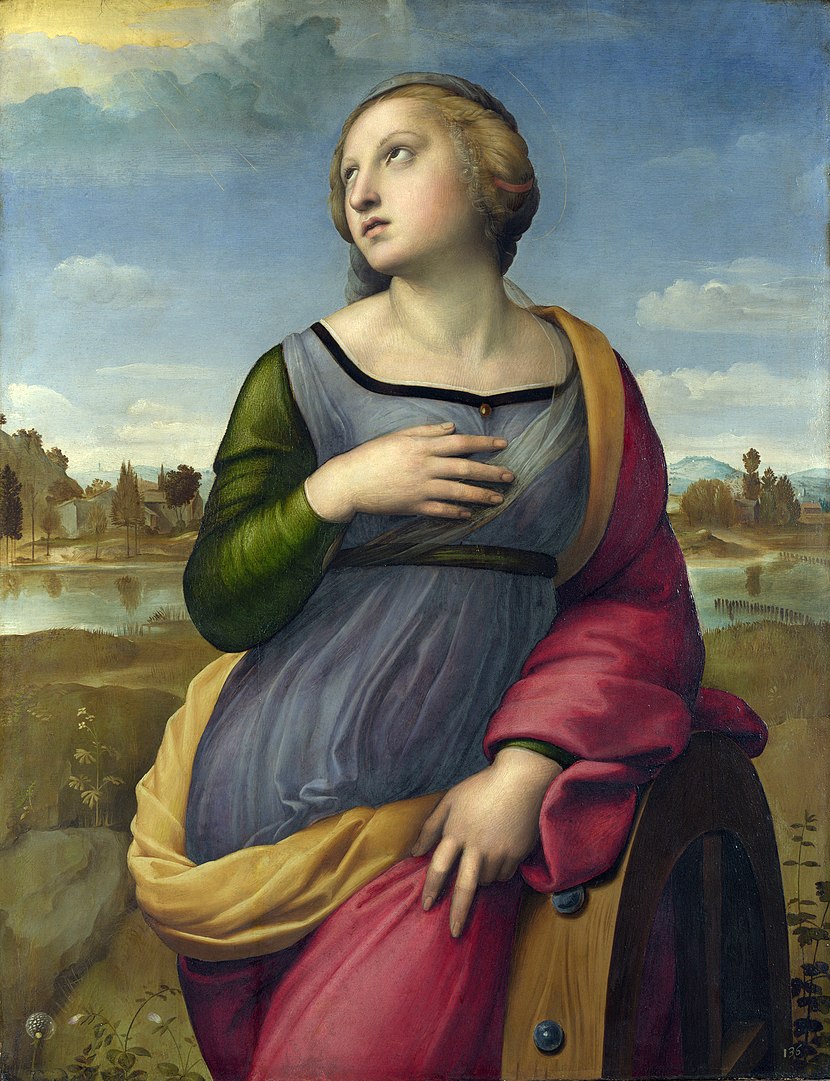
Much admired for her learning and heroic steadfastness in the face of persecution, Saint Catherine of Alexandria was one of the most widely venerated saints in medieval and early-modern Europe. According to her legend, Catherine was a 4th-century pagan princess who converted to Christianity at the age of 14. After converting a slew of state-sponsored philosophers sent by the emperor Maximian to convince her of the error of her ways, the enraged despot ordered Catherine to be subject to a horrifying series of tortures, including having her crushed on a spiked wheel. The wheel broke thanks to an intervention from on high, killing her torturers instead. Although the saint was subsequently decapitated, it is the wheel with which Catherine is most commonly associated, and in this radiantly beautiful portrait painted by Raphael for an unknown patron the elegant princess leans on the failed device of torture. Catherine’s sinuous contrapposto and delicate features turned towards heaven reflect Raphael at his most elegant, and the figure would be highly influential on painters in the coming decades.
Titian - The Death of Actaeon, c. 1559-75
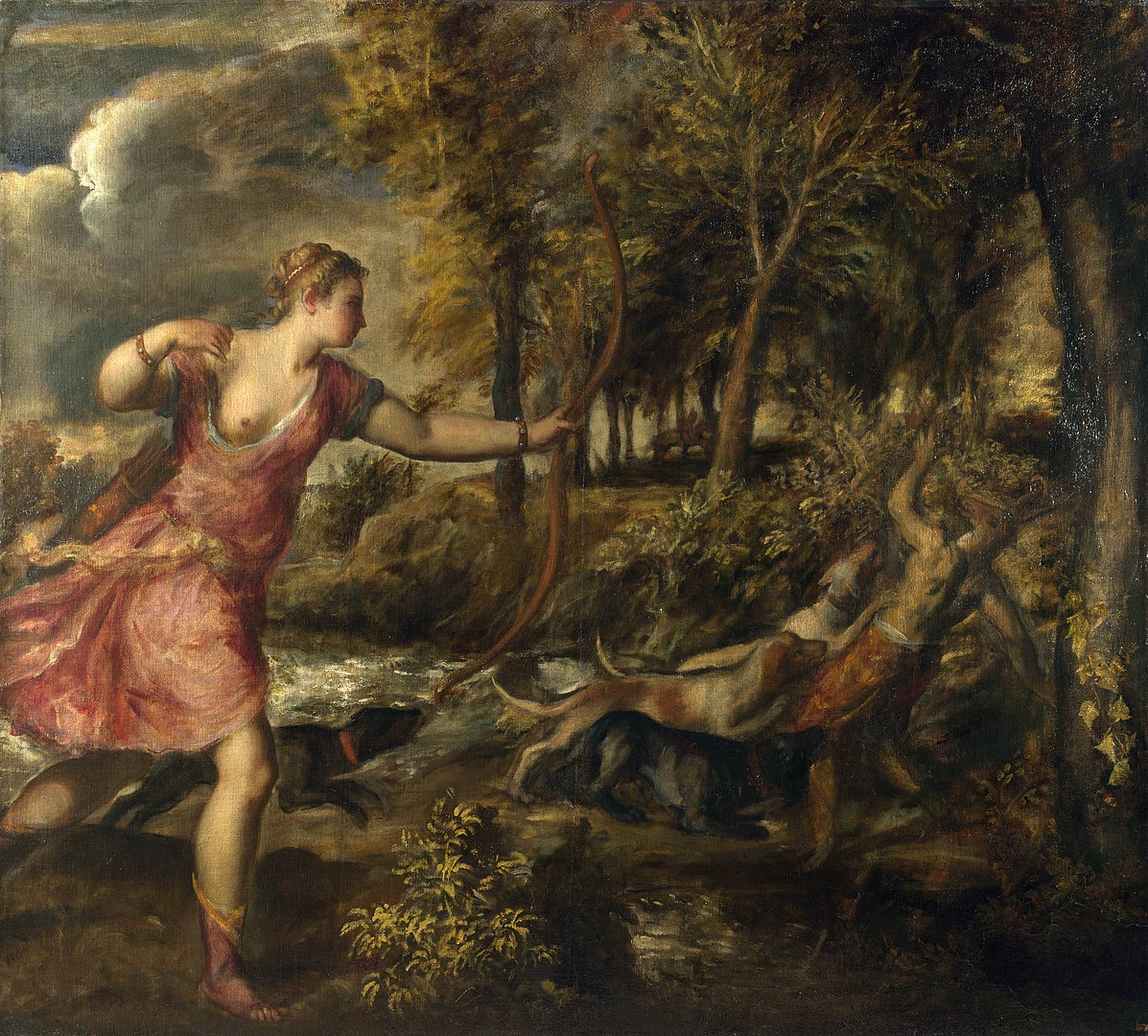
One of the final works painted by the Venetian master Titian, and left unfinished in his study at the time of his death in 1576, The Death of Actaeon depicts a dark tale of violence and punishment from the Roman poet Ovid’s Metamorphoses. Ovid relates how the hunter Actaeon accidentally stumbles across the ancient goddess of the hunt Diana and her attendant nymphs bathing naked in a woodland spring. The furious goddess splashes Actaeon’s face before goading him to tell the world of his forbidden vision. The terrified hunter flees, and Titian’s canvas takes up the action when he stops to slake his thirst in a stream. As Actaeon looks down into the water, he sees not his own face reflected up at him but that of a stag. The vindictive Diana, pictured firing her bow on the left of the scene, has transformed the hunter into his own quarry, soon to be mauled to death by his own hounds.
Titian’s dramatic canvas is a sequel to an earlier painting that depicted Actaeon coming across Diana and her nymphs, and forms part of a series of mythological paintings that the artist produced for King Philip II of Spain. This series, described by Titian as poesie because he considered them to be poems recast in painted form, is one of the landmarks of Venetian Renaissance art: Titian’s characteristically expressive use of colour and abstracted approach to form strongly differentiates his work from the harmonious compositions of his contemporaries in Florence and Rome.
Piero della Francesca - The Baptism of Christ, c. 1437
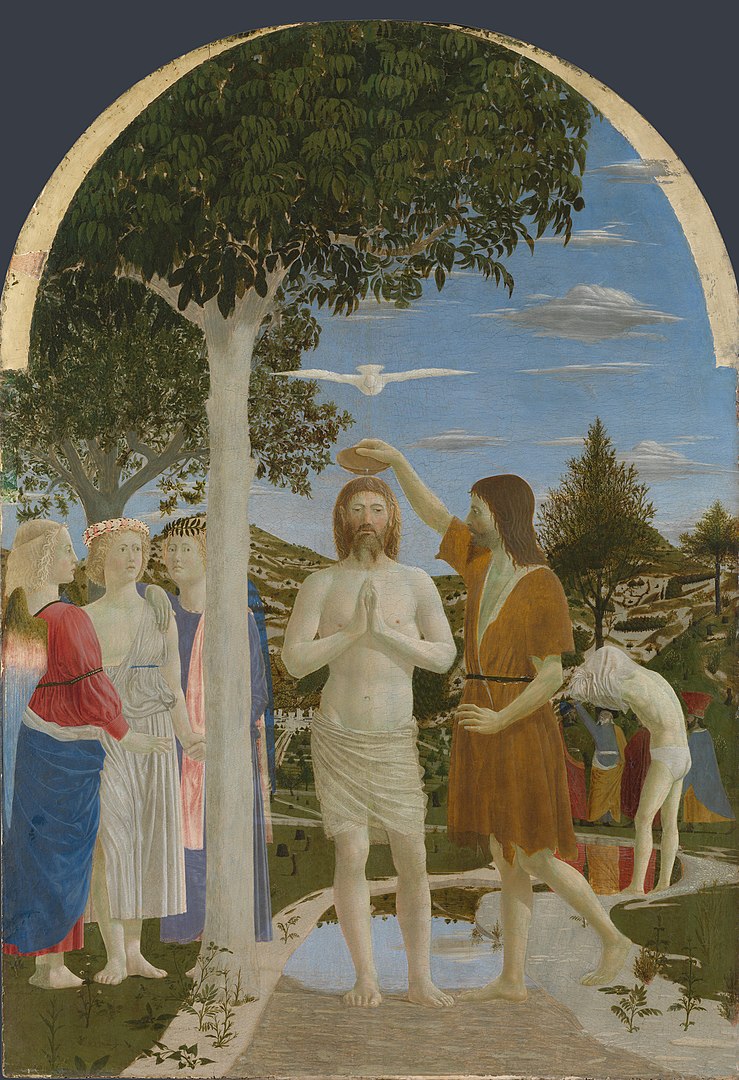
Piero della Francesca was one of the key figures in the development of a distinctively renaissance humanist idiom of painting in 15th-century Italy. The artist’s refined intellectual style was in high demand at the great courts of the Italian Renaissance; Piero worked for Sigismondo Malatesta in Rimini and Federico da Montefeltro in Urbino, for whom he painted some of his greatest panels - including the famous double portrait of the warrior prince and his wife Battista SForza now in the Uffizi gallery in Florence.
Piero’s skills extended far beyond a preternatural ability with the brush; his mathematical genius allowed him to make extraordinary steps forward in the science of perspective, a method of convincingly rendering three-dimensional objects on the flat surface of a painted panel. Piero’s treatise De prospectiva pingendi, published in the 1470s, was the first detailed treatment of the subject by an artist, and this aspect of his art magnificently demonstrated in the National Gallery’s Baptism of Christ.
Originally painted for a church in his small Tuscan hometown of Sansepolcro, this highly ordered composition depicts Christ being baptised in the shallow river Jordan as other figures wait their turn by the water’s age and three elegant angels watch the proceedings. Look at how water droplets trickle into Jesus’ hair from the bowl held by John the Baptist, and at the virtuoso foreshortening of Christ’s feet. Everything depicted in the painting, from the large figures in the foreground to the distant hills, are all rendered in a single, coherently mapped space - testament to the giant leap forward in perspective made by Piero della Francesca.
Giovanni Bellini, Doge Leonardo Loredan, c. 1501-2
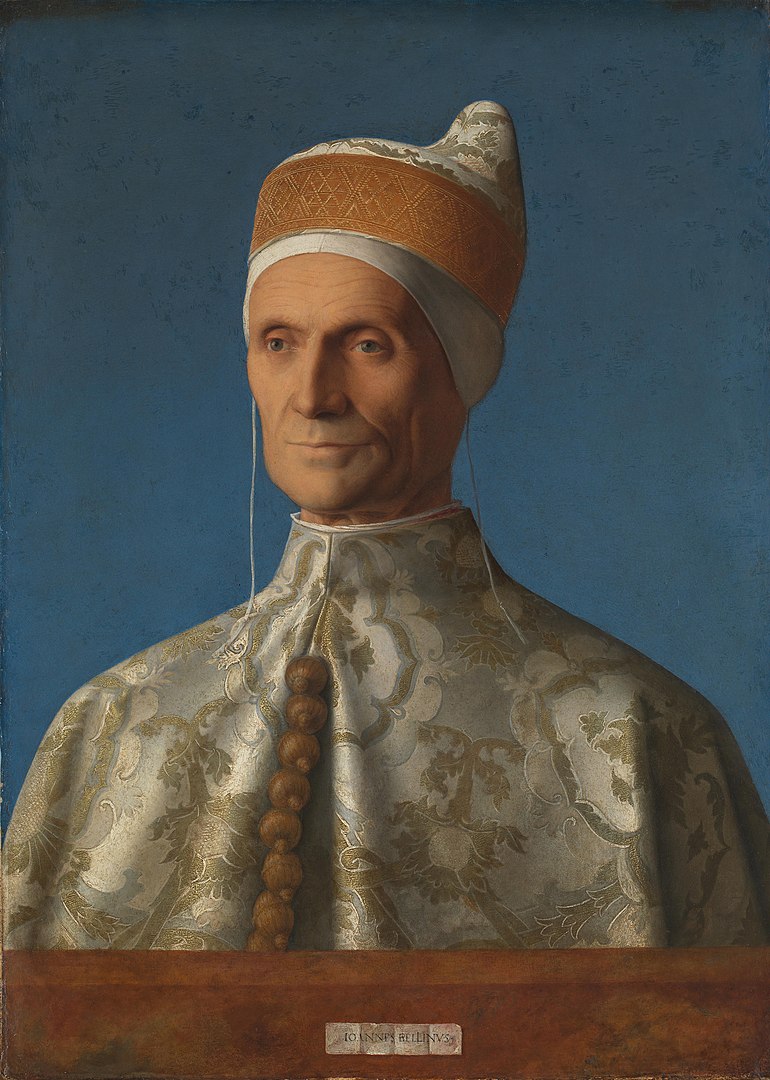
The majesty of Venice’s Maritime Republic is captured in all its pomp in this fabulous portrait of Doge Lorenzo Loredan, who ruled over the Serenissima from his election in 1501 to his death 20 years later. Although he gazes steadily out of the panel, his eyes are fixed somewhere beyond the viewer - probably on the serious affairs of state that were his constant concern. The identity of the sitter is made clear by the distinctive headgear he wears - known as the corno ducale, this exotic peaked bonnet was reserved for the Doge of Venice, typically only worn during official functions and events of state.
The elderly doge is decked out in robes of extraordinary finery, silken damask threaded with silver and gold all rendered with virtuoso precision by the painter Giovanni Bellini. Bellini was a member of Venice’s most influential artistic family - both his father and brother were famous painters in their own right, as was his brother-in-law Andra Mantegna - but Giovanni’s skill as a portraitist was unparalleled. In addition to the minute attention to detail Bellini pays to textures and surfaces, the sculptural three-dimensionality of the Doge confers upon him a startlingly life-like quality that departs from the formalised profile portraits common in 15th-century Venice.
Antonello da Messina - Jerome in his Study, c. 1475
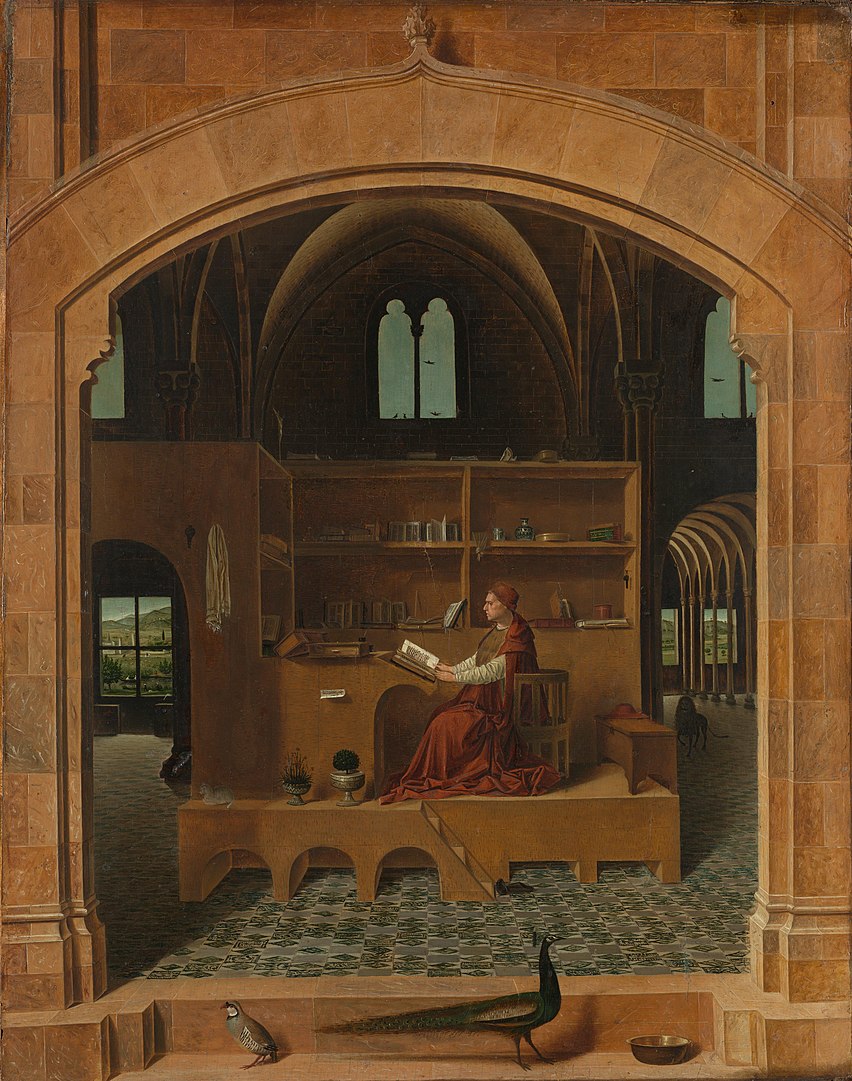
Historically credited as the man who introduced oil painting to Italy from northern Europe, Antonello da Messina was arguably the greatest Renaissance artist of southern Italy. Whilst modern scholarship has shown that Antonello was not in fact the first painter to utilise oil on the peninsula, he was certainly one of its leading exponents. Famous for his portraits and highly detailed cabinet paintings, Antonello’s luminous canvases recall the courtly Dutch tradition of Rogier van der Weyden and Jan van Eyck, whose paintings you can see in London’s National Gallery alongside this delightful miniature panel depicting the 4th-century church father and scholar Saint Jerome lost in thought in his study.
The innovative composition takes the format of cutaway view into the saint’s stage-like study, set into the cavernous space of a Gothic church. Everything in the scene is portrayed with incredible detail, from the books on the shelves to a garment hanging on a hook to plant pots lined up on the study’s ledge. Seen through an open arch that constitutes the painting’s fictional border, we seem to be privileged witnesses - or even voyeurs - into this private moment of reflection. Apart from Jerome, the only other sign of life in the painting is a lion trotting through the arcaded interior; the story goes that one day the saint encountered a distressed lion in the desert struggling with a thorn lodged in his paw. After Jerome extracted the offending barb, the fierce creature refused to leave his side and became his constant companion - that’s why you will almost always see Jerome depicted alongside a lion in Renaissance art!
Carlo Crivelli - The Annunciation with Saint Emidius, 1486
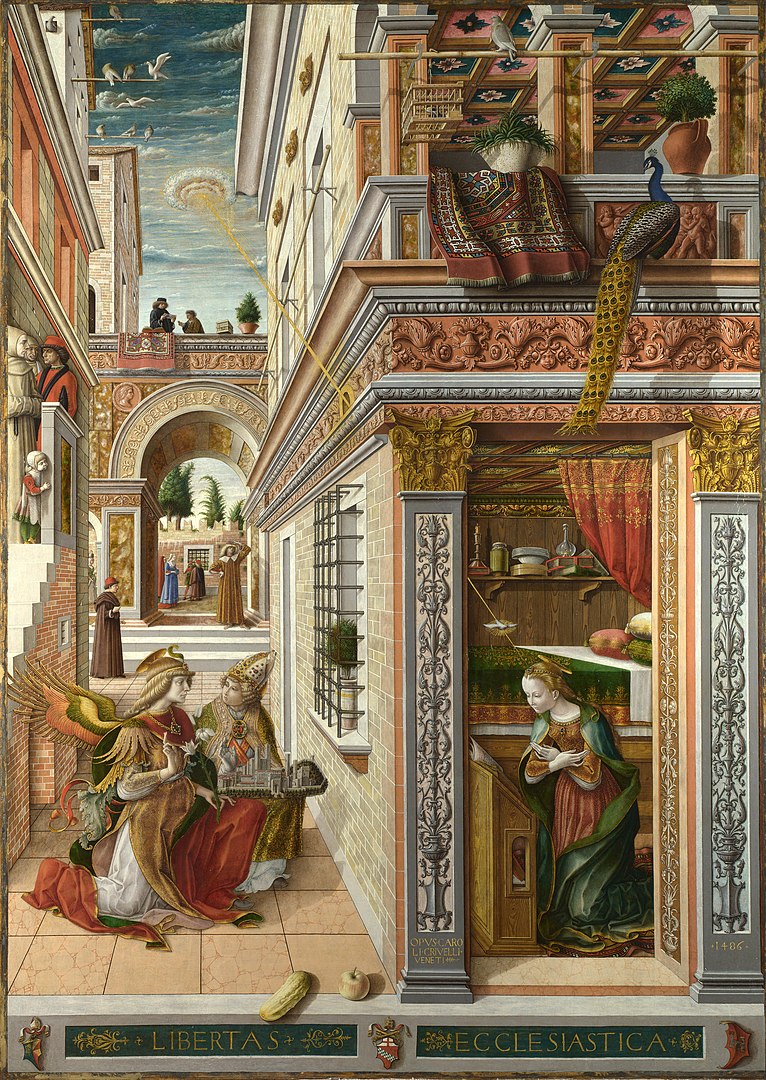
Admired by contemporaries for his decorative style and eccentric visual touches, after serving a jail term in Venice for adultery in his native Venice Carlo Crivelli spent most of his professional life painting grand altarpieces for churches in the eastern Italian region of Marche. In these provincial surroundings far from the established artistic hubs of Venice, Florence and Rome, Crivelli developed a highly distinctive painterly idiom that is beautifully represented in this altarpiece depicting the Annunciation, originally created for a church in the Marche town of Ascoli Piceno in 1486.
Daringly, the biblical narrative unfolds not in ancient Jerusalem, but instead on the streets of a recognisably Renaissance town. The archangel Gabriel, beautifully decked out in multicoloured wings and flowing robes, kneels before the entrance to a fantastically grand palace as the great and the good of Ascoli Piceno through the city’s gridded streets. Within, the Virgin Mary kneels piously before a lectern reading the bible as the dove of the Holy Spirit swoops down from on high. Accompanying Gabriel on his important mission to bring tidings of Mary’s miraculous pregnancy is local saint Emidius, who clutches a detailed model of the town of which he is the patron saint. Ascoli was granted additional freedoms of self-governance from the Papacy on the feast of the Annunciation in 1482, explaining the importance of the feast-day to the city.
The vertiginous perspective of this street scene, the fabulous architecture, the luxurious fabrics and the focus on vivid ornamental details all combine to make this one of the highlights of Renaissance painting in the National Gallery. Look out for the gnarly marrow and apple illusionistically hanging over the edge of the painting and protruding into our space beyond the panel - this kind of witty visual detail is a classic Crivelli calling card.
Through Eternity Tours offer expert-led guided itineraries across London. If you’d like to visit the National Gallery in the company of one of our resident art historians to learn more about the Renaissance masterpieces featured in this guide, be sure to check out our Best of London Tour with the National Gallery.
Public domain photos taken from wikimedia commons.



